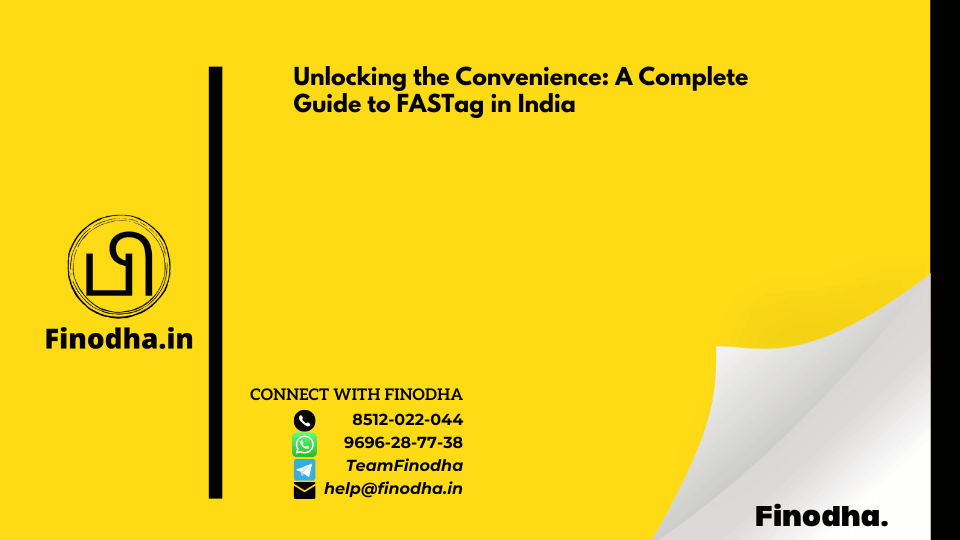Important Keyword: FASTag, RFID Toll Collection, Buy FASTag, Activate FASTag.
Table of Contents

Introduction to FASTag
FASTag is an innovative electronic toll collection system that has revolutionized the way toll payments are processed in India. Operated by the National Highway Authority of India (NHAI), FASTag uses radio-frequency identification (RFID) technology to facilitate seamless transactions at toll plazas. The primary purpose of FASTag is to promote efficiency and convenience for road users, significantly reducing the time spent waiting in queues at toll booths.
With the implementation of FASTag, vehicles equipped with these tags can pass through toll plazas without stopping, allowing for automatic deductions from a linked prepaid account. This system not only optimizes traffic flow but also minimizes the chances of congestion, which is a common issue at busy toll gates. Furthermore, the automation of toll collection reduces the reliance on physical cash, thereby promoting a cashless transaction environment on national highways.
Additionally, FASTag offers a range of benefits to drivers, including real-time tracking of transactions and balances through mobile applications. This feature enhances the overall user experience by providing transparency and control over toll expenditures. Moreover, as part of the government’s push for digitization, FASTag aligns with broader initiatives aimed at improving road infrastructure and making travel more efficient.
In essence, the introduction of FASTag marks a significant advancement in how toll collection operates in India. By adopting this technology, not only are drivers able to enjoy a more streamlined travel experience, but it also contributes to the overarching goals of reducing traffic congestion and facilitating economic growth through better infrastructure. As we delve deeper into the advantages and operational aspects of FASTag, it is essential to appreciate its role in modernizing toll collection in an ever-evolving transportation landscape.
What is FASTag?
FASTag is an innovative electronic toll collection system implemented across India to enhance the efficiency and convenience of toll payments on national and state highways. It employs Radio Frequency Identification (RFID) technology in a passive tag format, enabling automatic deduction of toll fees as vehicles pass through designated toll plazas. This system significantly minimizes congestion and waiting times at toll booths, promoting faster and more seamless travel experiences for commuters.
The core feature of FASTag is its rechargeable nature, eliminating the need for cash transactions at toll plazas. Users can link their FASTag to a bank account or a digital wallet, allowing for effortless top-ups. Additionally, the tag does not have an expiration date, which means once purchased, it can be used indefinitely as long as it is adequately funded. Each FASTag is associated with a unique vehicle registration number, ensuring accurate tracking and transactions as vehicles move past toll gates.
FASTag adheres to the guidelines provided by the National Payments Corporation of India (NPCI), specifically following the protocols set forth by the Ministry of Road Transport and Highways. This systemis not only beneficial for reducing travel time but also for improving financial transparency at toll plazas. As vehicles equipped with FASTag approach a toll barrier, sensors read the tag and deduct the appropriate toll fee automatically, providing an electronic receipt for each transaction. This integration of technology facilitates a cashless experience, reducing the need for physical money and thereby streamlining the entire toll collection process.
How FASTag Operates
FASTag serves as an electronic toll collection system in India, facilitating seamless toll payments for vehicle owners. This system operates on a prepaid basis, requiring users to load money onto their FASTag account prior to usage. Each FASTag is affixed to the vehicle’s windshield and is linked to the vehicle owner’s bank account or a digital wallet. When a vehicle approaches a toll plaza, the RFID (Radio Frequency Identification) technology embedded within the FASTag comes into play.
As the vehicle moves towards the toll booth, the FASTag communicates with the RFID reader installed at the toll plaza. This wireless communication captures the vehicle’s information, including the unique FASTag ID, and initiates the transaction process. Upon identification, the toll amount is automatically deducted from the user’s linked account without the need for cash transactions or physical manual toll collection, significantly enhancing the efficiency of toll payments.
Moreover, the integration of FASTag within the broader framework of electronic payment systems in India streamlines travel for motorists. It reduces congestion at toll plazas, allowing smoother traffic flow and minimizing waiting times. The Government of India mandated the use of FASTag for all vehicles from February 15, 2021, thereby ensuring uniformity in toll collection practices across the nation. This decision underscores the initiative’s role in promoting digital transactions and enhancing the overall travel experience for users.
Furthermore, vehicle owners can monitor their toll transactions through mobile apps or online platforms, ensuring transparency and better financial management. With affordability and practicality at the forefront of this technology, FASTag not only benefits individual travelers but also contributes to the broader objective of digitizing India’s transportation system.
How to Purchase FASTag?
Acquiring a FASTag is a straightforward process, thanks to the various purchasing options available across India. The FASTag system is designed to facilitate electronic toll payments, promoting seamless travel on national highways. To purchase a FASTag, one can explore several avenues, including certified banks, toll plazas, Regional Transport Offices (RTOs), and select petrol pumps. Additionally, online platforms such as Amazon and Paytm offer a convenient way to obtain this vital electronic tag.
Certified banks, such as HDFC Bank, ICICI Bank, and State Bank of India (SBI), are authorized to issue FASTags. Potential buyers can visit their nearest branch, where they must provide essential documents like the vehicle registration certificate, proof of identity, and, in some instances, a passport-sized photograph. Upon successful verification, the bank will issue a unique FASTag linked to the provided vehicle, enabling automatic deduction of toll charges while traveling.
For those seeking instant purchase options, toll plazas across major highways have dedicated kiosks where travelers can acquire FASTag on the spot. Similar to the banking process, individuals will need to present their vehicle documents, enabling a quick and efficient acquisition right before their journey. RTOs and select petrol pumps also facilitate the purchase of FASTags, providing an additional layer of accessibility for consumers.
Online platforms have revolutionized the way customers access services, and FASTag is no exception. By visiting websites like Amazon or payment applications such as Paytm, users can select their preferred FASTag variant, make the required payment, and have the tag delivered to their doorstep. It is essential to note that each vehicle needs a unique FASTag, ensuring accurate toll deductions and maintaining a hassle-free travel experience.
How to Activate FASTag?
Activating FASTag is a straightforward process that can be accomplished through two primary methods: self-activation via the FASTag app or manual activation at bank branches. Each of these methods has distinct steps to follow, catering to different preferences and technological access.
To initiate self-activation, users must first download the FASTag app, which is available on both Android and iOS platforms. Once downloaded, users should create an account by providing their mobile number and completing the registration process. After successfully creating an account, users can apply for a FASTag by entering the required details, such as vehicle registration information. It is essential to upload the necessary KYC documents, including a government-issued ID and vehicle registration certificate, for verification. Upon verification, users will receive their FASTag, which can be linked to a prepaid wallet facility provided by the National Highways Authority of India (NHAI). This wallet allows for seamless recharge and automatic deductions at toll plazas, enhancing the convenience of traveling.
Alternatively, individuals who prefer manual activation can visit their bank branch that offers FASTag services. At the branch, applicants will need to fill out an application form and present the required KYC documentation. Typical documents include a copy of the driver’s license, a passport-sized photograph, and the vehicle registration certificate. Once the application is submitted and the payment for the FASTag is made, the bank will process the request. After completing the activation, users will also receive the link to activate their prepaid wallet.
Regardless of the activation method chosen, it is crucial to ensure that all submitted documents are correct and valid to avoid delays. By activating FASTag, users can enjoy numerous benefits, including reduced waiting times at toll plazas and hassle-free travel across national highways in India.
Advantages of Using FASTag
The introduction of FASTag in India has revolutionized the way vehicle owners navigate toll roads. One of the most prominent advantages is the significant time savings by allowing users to bypass long queues at toll booths. Traditional cash transactions often lead to delays caused by manual collection of toll fees, while FASTag facilitates a seamless passage through designated lanes. This efficiency is particularly beneficial during peak travel times, ensuring that drivers spend less time at toll gates and more time on the road.
Additionally, FASTag promotes a cashless economy by enabling electronic toll payments. With the automatic deduction of toll charges from the user’s linked bank account or prepaid wallet, vehicle owners can travel without carrying cash. This not only reduces the physical handling of currency but also mitigates the risk of theft or loss associated with carrying large sums of cash. The cashless system also contributes to enhanced safety and hygiene, which has become increasingly important in recent times.
Furthermore, FASTag provides vehicle owners with real-time updates about their account balance and transaction history via mobile applications. This feature allows users to track their toll expenditures and manage their travel budget with ease. The ability to monitor balances means that drivers can recharge their FASTag accounts proactively, avoiding any disruptions during their journeys. As such, FASTag enhances the overall travel experience on highways, making it more enjoyable and convenient for long-distance travel.
In summary, the benefits of adopting FASTag extend beyond mere convenience. By allowing for quick passage through toll booths, promoting cashless transactions, and ensuring transparency in spending, FASTag positions itself as an invaluable tool for modern vehicle owners in India.
Disadvantages or Challenges with FASTag
While the FASTag system has greatly enhanced the toll payment experience on Indian highways, it is not without its challenges and drawbacks. A primary concern is the potential for system failures and technical glitches that can disrupt the seamless process of toll payments. Instances have been reported where drivers faced delays at toll plazas due to faulty scanners or network issues preventing the recognition of FASTags. Such disruptions can lead to extended waiting times, counteracting the convenience that FASTag aims to provide.
Another associated challenge is the requirement for consistent internet connectivity during the recharging process. Users must ensure that they have a stable internet connection to top-up their FASTag accounts effectively. This dependency can be inconvenient for individuals traveling in remote areas where internet access may be unreliable, creating potential barriers to maintaining a sufficient balance for toll payments.
Moreover, the physical integrity of the FASTag is critical for its effectiveness. Damaged or worn-out tags can fail to register at toll booths, leading to additional hassle for the user. If the tag is not functioning correctly, the vehicle owner may still be required to pay toll fees in cash, undermining the very purpose of having a FASTag. In some cases, users may find themselves needing to replace damaged tags, which can incur additional costs and inconvenience.
Lastly, the integration of FASTag with various payment platforms can sometimes present a learning curve for new users. Individuals who are not well-versed in technology may struggle to navigate the app interfaces or understand the recharging process, which could complicate their overall experience. These aspects of the FASTag system highlight the need for ongoing improvements to further enhance its functionality and user accessibility.
FAQs about FASTag
As FASTag becomes increasingly popular among motorists in India, it is natural for users to have questions about its functionality and management. Below are some of the most frequently asked questions regarding FASTag.
What to do if my FASTag is not working? If you encounter issues with your FASTag not working at a toll plaza, the first step is to check the balance in your FASTag account. Insufficient balance may prevent successful transactions. You can also ensure that the FASTag is correctly affixed to your vehicle’s windscreen, as improper placement can hinder its scanning ability. If, after checking these factors, the issue persists, contacting your FASTag issuer’s customer service is advisable. They can assist in troubleshooting or potentially issuing a replacement.
How to recharge my FASTag account? Recharging your FASTag account is a straightforward process. Most banks and payment platforms offer online recharging options. You can log in to your bank’s mobile application or website to add money to your FASTag account using net banking, debit cards, or credit cards. Additionally, some users may prefer to recharge at designated points like toll plazas or banking branches. It is essential to maintain a sufficient balance to avoid interruptions while traveling through toll gates.
How to check my FASTag balance? Checking your FASTag balance can be done via your bank’s mobile app or website. Many issuers provide SMS services to send balance alerts directly to your registered mobile number. Regularly monitoring your balance ensures you can plan recharges ahead of long trips to avoid inconvenience at toll plazas.
Can I use one FASTag for multiple vehicles? Each vehicle should have its dedicated FASTag, as the tags are linked to the vehicle’s registration number. Attempting to use one tag for multiple vehicles can lead to a violation of regulations and possible fines.
Conclusion and Key Takeaways
The implementation of FASTag in India has revolutionized the way commuters handle toll payments on national highways. This electronic toll collection system, which uses RFID technology, enables automatic deduction of toll fees from the user’s prepaid account, significantly reducing wait times at toll plazas. The convenience of not having to carry cash or stop for manual toll transactions has made FASTag an essential tool for frequent travelers.
Throughout this guide, we explored the core functionalities of FASTag, highlighting how it streamlines the travel experience. With the RFID tags affixed to vehicles, drivers can pass through toll booths without halting, promoting a smoother flow of traffic and minimizing congestion. Additionally, the integration of FASTag with digital wallets and banking apps enhances its usability by making it easy for users to recharge their tags and monitor their balance effortlessly.
While the advantages of using FASTag are numerous, including cost savings from reduced travel time and better budgeting through detailed transaction history, there are also potential challenges to consider. Issues such as tag malfunction, connectivity problems, or disputes regarding toll charges can sometimes arise. However, the government has actively worked towards addressing these concerns by providing customer support and guidelines for resolving conflicts effectively.
In light of the benefits and the enhanced convenience offered by FASTag, it is strongly recommended for all motorists to adopt this system. Not only does it facilitate a quick passage through toll gates, but it also contributes to the larger objective of digitizing transportation and improving road safety in India. Adopting FASTag ultimately leads to a more efficient and enjoyable travel experience, reinforcing its value in modern transportation practices.
Download Pdf: https://taxinformation.cbic.gov.in/




